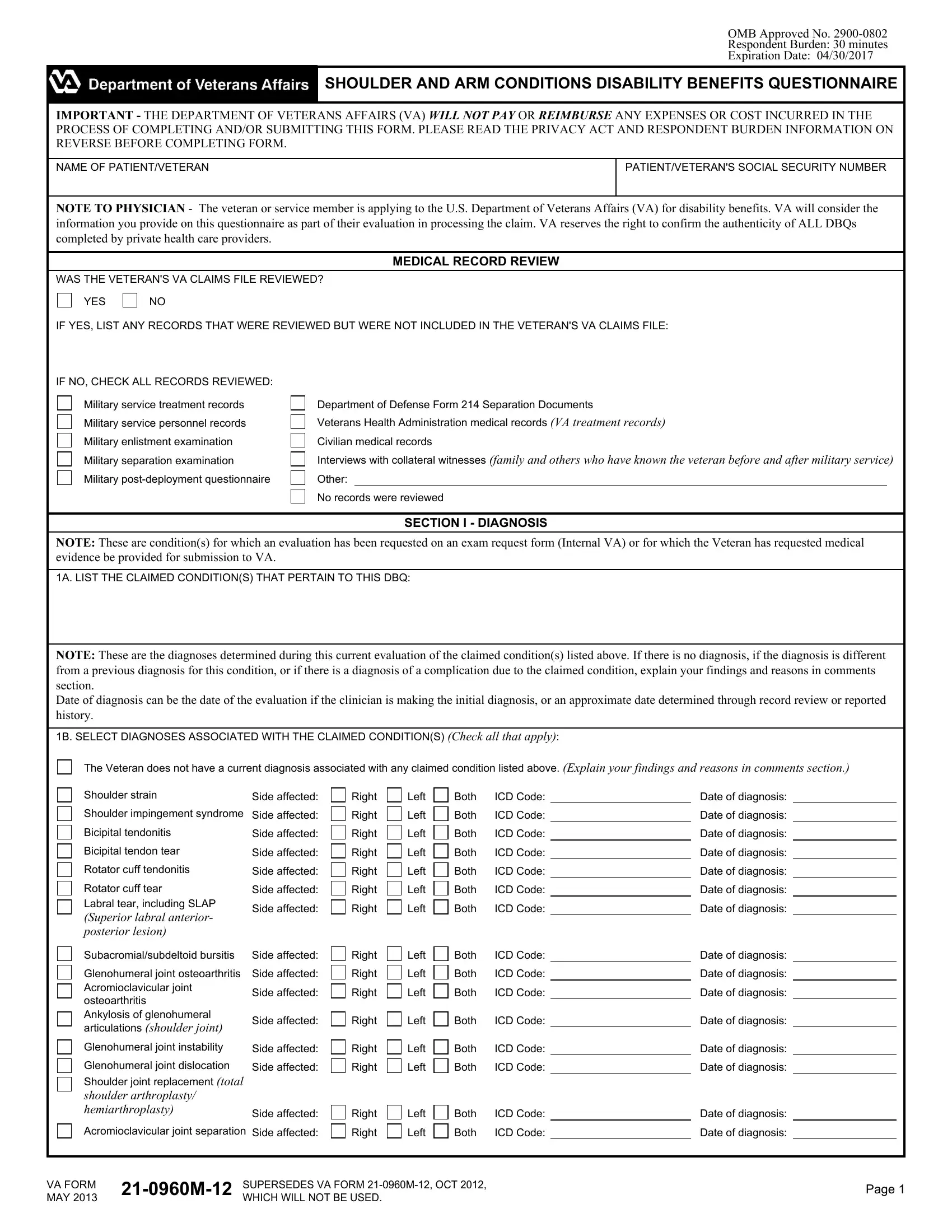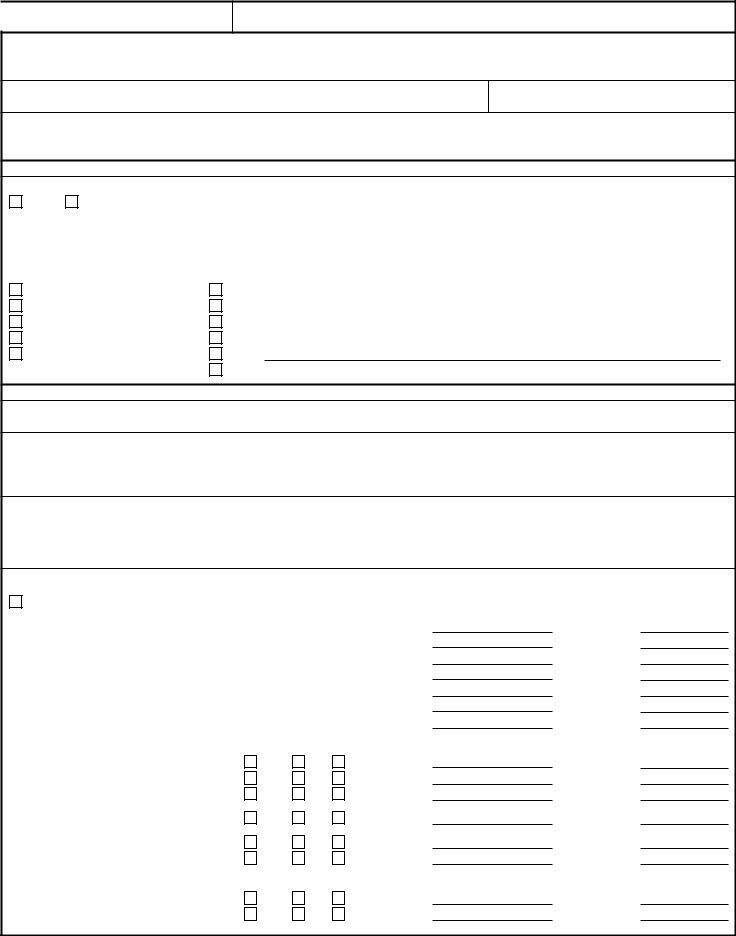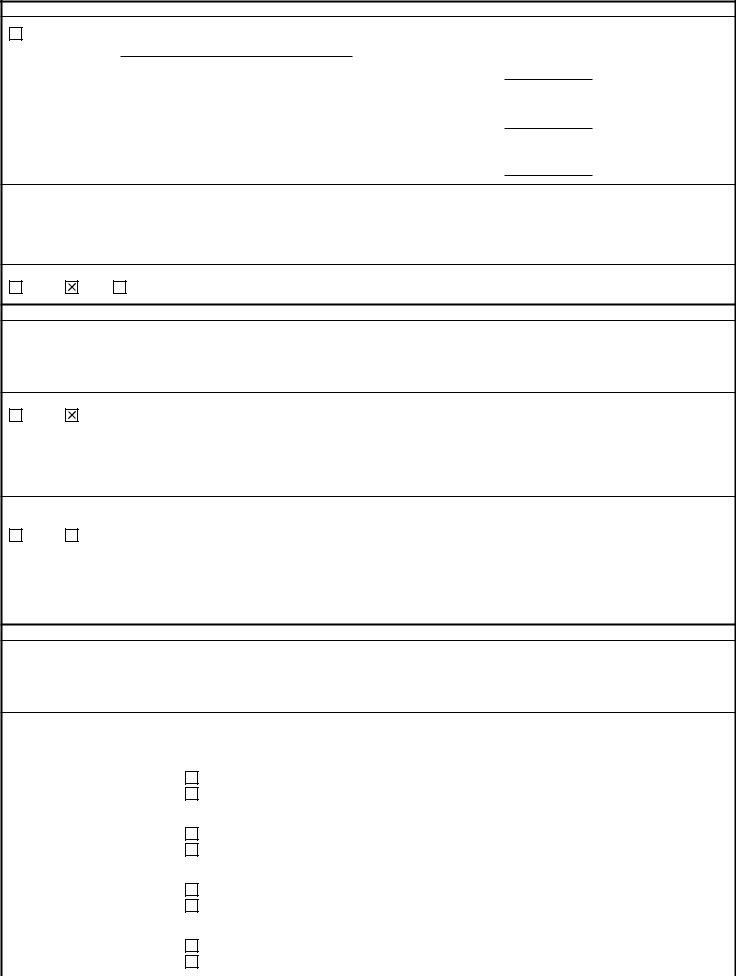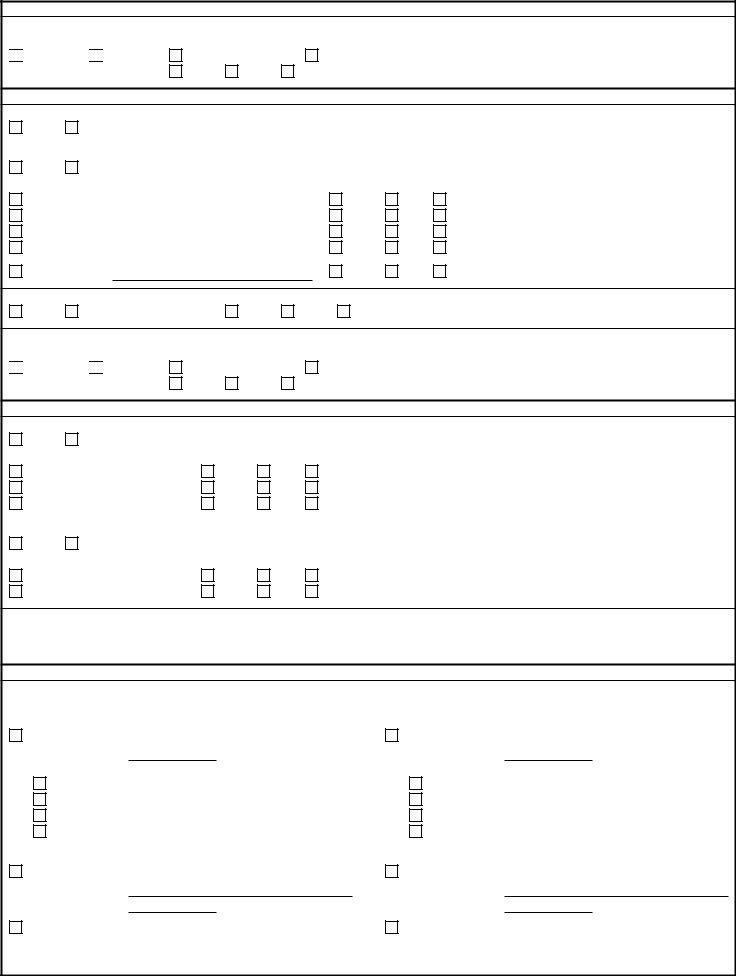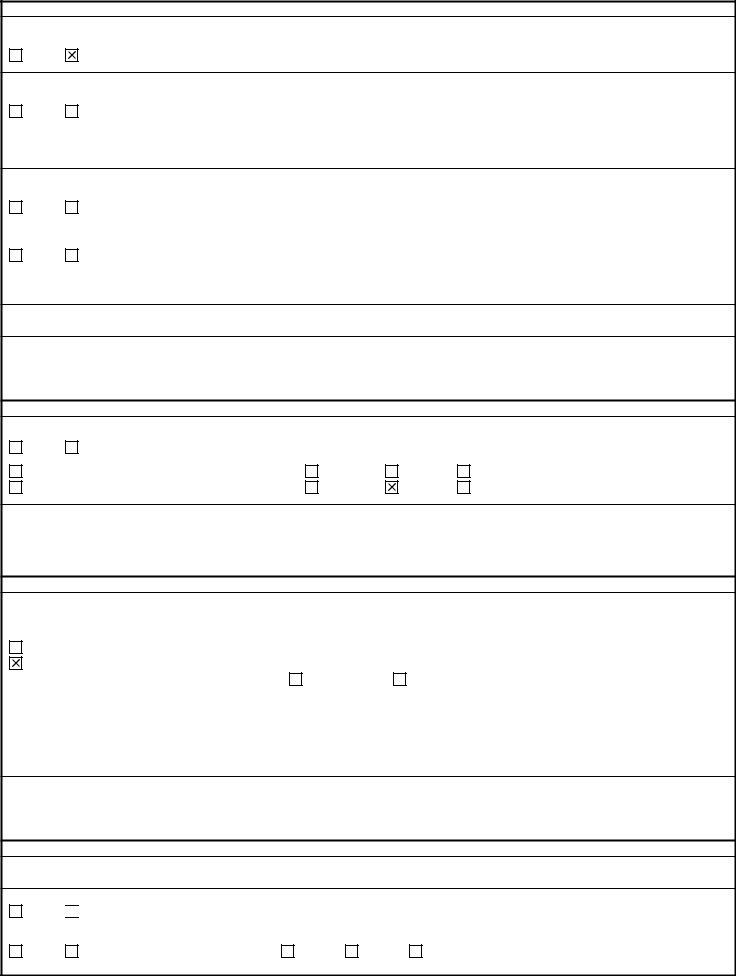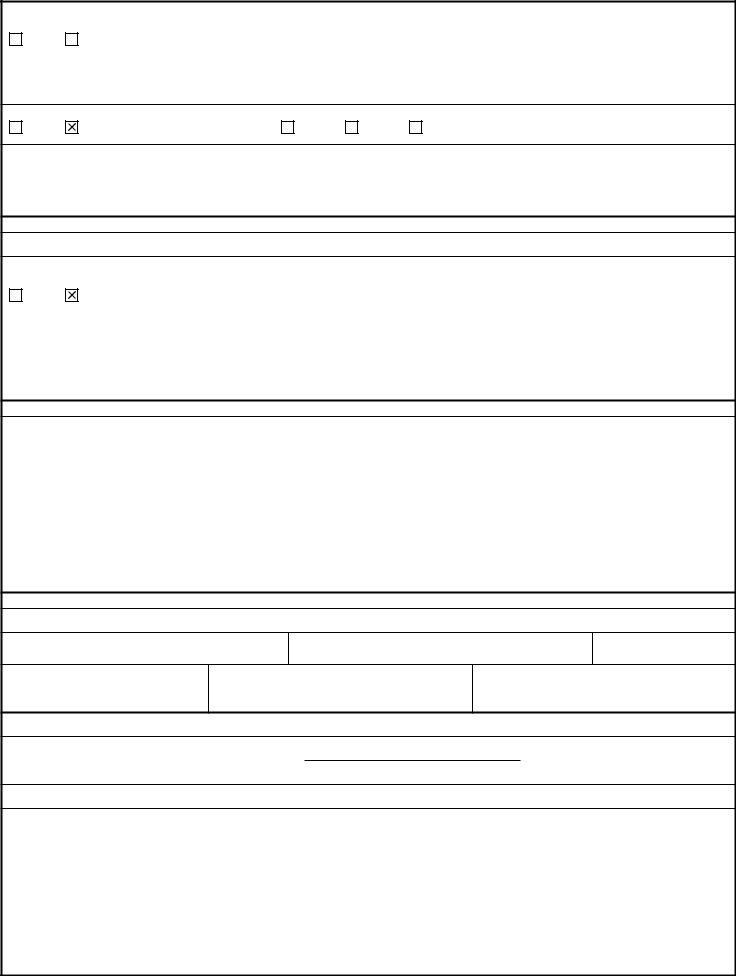OMB Approved No. 2900-0802
Respondent Burden: 30 minutes
Expiration Date: 04/30/2017
SHOULDER AND ARM CONDITIONS DISABILITY BENEFITS QUESTIONNAIRE
IMPORTANT - THE DEPARTMENT OF VETERANS AFFAIRS (VA) WILL NOT PAY OR REIMBURSE ANY EXPENSES OR COST INCURRED IN THE PROCESS OF COMPLETING AND/OR SUBMITTING THIS FORM. PLEASE READ THE PRIVACY ACT AND RESPONDENT BURDEN INFORMATION ON REVERSE BEFORE COMPLETING FORM.
PATIENT/VETERAN'S SOCIAL SECURITY NUMBER
NOTE TO PHYSICIAN - The veteran or service member is applying to the U.S. Department of Veterans Affairs (VA) for disability benefits. VA will consider the information you provide on this questionnaire as part of their evaluation in processing the claim. VA reserves the right to confirm the authenticity of ALL DBQs completed by private health care providers.
MEDICAL RECORD REVIEW
WAS THE VETERAN'S VA CLAIMS FILE REVIEWED?
IF YES, LIST ANY RECORDS THAT WERE REVIEWED BUT WERE NOT INCLUDED IN THE VETERAN'S VA CLAIMS FILE:
IF NO, CHECK ALL RECORDS REVIEWED:
Military service treatment records Military service personnel records Military enlistment examination Military separation examination Military post-deployment questionnaire
Department of Defense Form 214 Separation Documents
Veterans Health Administration medical records (VA treatment records)
Civilian medical records
Interviews with collateral witnesses (family and others who have known the veteran before and after military service)
Other:
No records were reviewed
SECTION I - DIAGNOSIS
NOTE: These are condition(s) for which an evaluation has been requested on an exam request form (Internal VA) or for which the Veteran has requested medical evidence be provided for submission to VA.
1A. LIST THE CLAIMED CONDITION(S) THAT PERTAIN TO THIS DBQ:
NOTE: These are the diagnoses determined during this current evaluation of the claimed condition(s) listed above. If there is no diagnosis, if the diagnosis is different from a previous diagnosis for this condition, or if there is a diagnosis of a complication due to the claimed condition, explain your findings and reasons in comments section.
Date of diagnosis can be the date of the evaluation if the clinician is making the initial diagnosis, or an approximate date determined through record review or reported history.
1B. SELECT DIAGNOSES ASSOCIATED WITH THE CLAIMED CONDITION(S) (Check all that apply):
The Veteran does not have a current diagnosis associated with any claimed condition listed above. (Explain your findings and reasons in comments section.)
|
Shoulder strain |
Side affected: |
|
Right |
|
Left |
|
Both |
ICD Code: |
|
Shoulder impingement syndrome |
Side affected: |
|
Right |
|
Left |
|
Both |
ICD Code: |
|
|
|
|
|
Bicipital tendonitis |
|
|
|
|
|
|
|
|
|
Side affected: |
|
Right |
|
Left |
|
Both |
ICD Code: |
|
Bicipital tendon tear |
Side affected: |
|
Right |
|
Left |
|
Both |
ICD Code: |
|
|
|
|
|
Rotator cuff tendonitis |
|
|
|
|
|
|
|
|
|
Side affected: |
|
Right |
|
Left |
|
Both |
ICD Code: |
|
Rotator cuff tear |
Side affected: |
|
Right |
|
Left |
|
Both |
ICD Code: |
|
|
|
|
|
Labral tear, including SLAP |
Side affected: |
|
Right |
|
Left |
|
Both |
ICD Code: |
|
|
|
|
|
(Superior labral anterior- |
|
|
|
|
|
|
|
|
|
|
|
|
|
posterior lesion) |
|
|
|
|
|
|
|
|
Date of diagnosis: Date of diagnosis: Date of diagnosis: Date of diagnosis: Date of diagnosis: Date of diagnosis: Date of diagnosis:
|
Subacromial/subdeltoid bursitis |
Side affected: |
|
Glenohumeral joint osteoarthritis |
Side affected: |
|
|
Acromioclavicular joint |
Side affected: |
|
|
osteoarthritis |
|
|
|
Ankylosis of glenohumeral |
Side affected: |
|
|
articulations (shoulder joint) |
|
|
|
Glenohumeral joint instability |
Side affected: |
|
|
Glenohumeral joint dislocation |
Side affected: |
|
|
Shoulder joint replacement (total |
|
|
|
|
shoulder arthroplasty/ |
|
|
|
|
hemiarthroplasty) |
Side affected: |
|
|
|
Acromioclavicular joint separation |
Side affected: |
|
|
Right |
|
Left |
|
Both |
ICD Code: |
|
Right |
|
Left |
|
Both |
ICD Code: |
|
|
|
|
Right |
|
Left |
|
Both |
ICD Code: |
|
|
|
|
Right |
|
Left |
|
Both |
ICD Code: |
|
|
|
|
Right |
|
Left |
|
Both |
ICD Code: |
|
|
|
|
Right |
|
Left |
|
Both |
ICD Code: |
|
|
|
|
Right |
|
Left |
|
Both |
ICD Code: |
|
|
|
|
Right |
|
Left |
|
Both |
ICD Code: |
|
|
|
Date of diagnosis: Date of diagnosis: Date of diagnosis:
Date of diagnosis:
Date of diagnosis: Date of diagnosis:
Date of diagnosis: Date of diagnosis:
VA FORM |
21-0960M-12 |
SUPERSEDES VA FORM 21-0960M-12, OCT 2012, |
Page 1 |
MAY 2013 |
WHICH WILL NOT BE USED. |
|
|
|
SECTION I - DIAGNOSIS (Continued)
Other (specify)
Other diagnosis #1:
Side affected: |
|
|
Right |
|
Left |
|
Both |
ICD Code: |
|
|
Date of diagnosis: |
Other diagnosis #2: |
|
|
|
|
|
|
|
|
|
|
Side affected: |
|
|
Right |
|
Left |
|
Both |
ICD Code: |
|
|
Date of diagnosis: |
|
|
|
|
|
|
Other diagnosis #3: |
|
|
|
|
|
|
|
|
|
|
Side affected: |
|
|
Right |
|
Left |
|
Both |
ICD Code: |
|
|
Date of diagnosis: |
|
|
|
|
|
|
1C. COMMENTS (if any):
1D. WAS AN OPINION REQUESTED ABOUT THIS CONDITION (internal VA only)?
SECTION II - MEDICAL HISTORY
2A. DESCRIBE THE HISTORY (including onset and course) OF THE VETERAN'S SHOULDER OR ARM CONDITION (brief summary):
2B. DOES THE VETERAN REPORT THAT FLARE-UPS IMPACT THE FUNCTION OF THE SHOULDER OR ARM?
IF YES, DOCUMENT THE VETERAN'S DESCRIPTION OF THE IMPACT OF FLARE-UPS IN HIS OR HER OWN WORDS:
2C. DOES THE VETERAN REPORT HAVING ANY FUNCTIONAL LOSS OR FUNCTIONAL IMPAIRMENT OF THE JOINT OR EXTREMITY BEING EVALUATED ON THIS
DBQ (regardless of repetitive use)?
IF YES, DOCUMENT THE VETERAN'S DESCRIPTION OF FUNCTIONAL LOSS OR FUNCTIONAL IMPAIRMENT IN HIS OR HER OWN WORDS:
SECTION III - INITIAL RANGE OF MOTION (ROM) MEASUREMENTS
Measure ROM with a goniometer. During the examination be cognizant of painful motion, which could be evidenced by visible behavior such as facial expression, wincing, etc..., on pressure or manipulation. Document painful movement in Section 5.
Following the initial assessment of ROM, perform repetitive use testing. For VA purposes, repetitive use testing must be included in all joint exams. The VA has determined that 3 repetitions of ROM (at a minimum) can serve as a representative test of the effect of repetitive use. After the initial measurement, reassess ROM after 3 repetitions. Report post-test measurements in question 4A.
3A. INITIAL ROM MEASUREMENTS
Shoulder |
Joint Movement |
|
|
ROM Measurement |
If ROM testing is not indicated for the veteran's condition or not able to be performed, |
|
|
please explain why, and then proceed to Section 5: |
|
|
|
|
|
|
|
|
|
|
|
|
|
|
|
|
Flexion |
|
|
|
|
|
|
|
|
|
|
Not indicated |
|
|
|
|
|
|
(normal endpoint |
|
|
|
|
|
= 180 degrees) |
|
|
|
Not able to perform |
|
|
|
|
|
|
|
|
|
|
|
|
|
|
|
|
|
|
|
RIGHT |
Abduction |
|
|
|
|
|
|
|
|
Not indicated |
|
|
|
|
(normal endpoint |
|
|
|
|
SHOULDER |
|
|
|
|
= 180 degrees) |
|
|
|
Not able to perform |
|
|
|
|
|
|
|
|
|
|
|
|
|
|
|
|
|
|
|
|
|
|
|
|
|
External Rotation |
|
|
|
|
|
|
|
|
|
Not indicated |
|
|
|
|
|
|
(normal endpoint |
|
|
|
|
|
= 90 degrees) |
|
|
|
Not able to perform |
|
|
|
|
|
|
|
|
|
|
|
|
|
|
|
|
|
|
|
|
Internal Rotation |
|
|
|
|
|
|
|
|
|
Not indicated |
|
|
|
|
|
|
(normal endpoint |
|
|
|
|
|
= 90 degrees) |
|
|
|
Not able to perform |
|
|
|
|
|
|
|
|
|
|
|
|
|
|
|
|
|
|
|
VA FORM 21-0960M-12, MAY 2013 |
Page 2 |
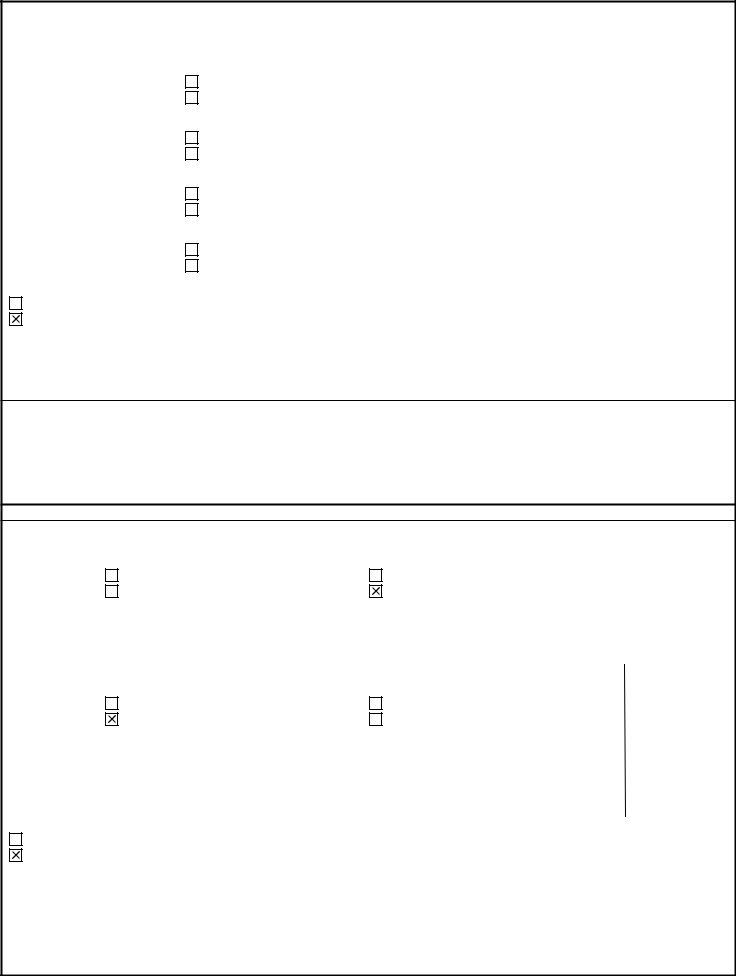
|
|
|
SECTION III - INITIAL RANGE OF MOTION (ROM) MEASUREMENTS (Continued) |
3A. INITIAL ROM MEASUREMENTS |
|
|
|
|
|
|
|
|
|
|
|
|
|
|
|
|
|
|
|
|
Shoulder |
Joint Movement |
|
|
ROM Measurement |
|
If ROM testing is not indicated for the veteran's condition or not able to be performed, |
|
|
|
|
|
|
please explain why, and then proceed to Section 5: |
|
|
|
|
|
|
|
|
|
|
|
|
|
|
|
|
|
|
|
|
|
|
|
|
|
|
Flexion |
|
|
|
|
|
|
|
|
|
|
|
|
|
|
Not indicated |
|
|
|
|
|
|
|
|
|
|
|
|
|
|
(normal endpoint |
|
|
|
|
|
|
|
|
|
= 180 degrees) |
|
|
|
Not able to perform |
|
|
|
|
|
|
|
|
|
|
|
|
|
|
|
|
|
|
|
|
|
|
|
|
|
|
|
|
|
|
|
|
|
|
|
LEFT |
Abduction |
|
|
|
|
|
|
|
|
|
|
|
|
Not indicated |
|
|
|
|
|
|
|
|
|
|
|
|
(normal endpoint |
|
|
|
|
|
|
|
SHOULDER |
|
|
|
|
|
|
|
= 180 degrees) |
|
|
|
Not able to perform |
|
|
|
|
|
|
|
|
|
|
|
|
|
|
|
|
|
|
|
|
|
|
|
|
|
|
|
|
|
|
|
|
|
|
|
|
|
|
|
|
|
|
|
|
External Rotation |
|
|
|
|
|
|
|
|
|
|
|
|
|
Not indicated |
|
|
|
|
|
|
|
|
|
|
|
|
|
|
(normal endpoint |
|
|
|
|
|
|
|
|
|
= 90 degrees) |
|
|
|
Not able to perform |
|
|
|
|
|
|
|
|
|
|
|
|
|
|
|
|
|
|
|
|
|
|
|
|
|
|
|
|
|
|
|
|
|
|
|
|
Internal Rotation |
|
|
|
|
|
|
|
|
|
|
|
|
|
Not indicated |
|
|
|
|
|
|
|
|
|
|
|
|
|
|
(normal endpoint |
|
|
|
|
|
|
|
|
|
= 90 degrees) |
|
|
|
Not able to perform |
|
|
|
|
|
|
|
|
|
|
|
|
|
|
|
|
|
|
|
|
|
|
|
|
|
|
|
|
|
|
|
|
|
3B. DO ANY ABNORMAL ROMs NOTED ABOVE CONTRIBUTE TO FUNCTIONAL LOSS? |
|
|
|
YES (you will be asked to further describe these limitations in Section 6 below) |
|
|
|
|
|
|
NO, EXPLAIN WHY THE ABNORMAL ROMs DO NOT CONTRIBUTE: |
|
|
|
|
|
|
3C. IF ROM DOES NOT CONFORM TO THE NORMAL RANGE OF MOTION IDENTIFIED ABOVE BUT IS NORMAL FOR THIS VETERAN (for reasons other than a
shoulder or arm condition, such as age, body habitus, neurologic disease), EXPLAIN:
SECTION IV - ROM MEASUREMENTS AFTER REPETITIVE USE TESTING
4A. POST-TEST ROM MEASUREMENTS
|
|
Shoulder |
|
|
Is the veteran able to perform repetitive-use testing? |
|
Is there additional limitation in ROM |
Joint Movement |
Post-test ROM |
|
|
|
|
|
|
after repetitive-use testing? |
Measurement |
|
|
|
|
|
|
|
|
|
|
|
|
|
|
|
|
|
|
|
|
|
|
|
|
|
|
|
Yes |
|
|
Yes |
Flexion |
|
|
|
|
|
|
|
|
|
|
|
|
|
|
|
|
|
|
No |
|
|
No, there is no change in ROM |
|
|
|
|
|
|
|
|
|
|
|
|
|
|
|
|
|
|
|
|
|
|
|
|
|
|
|
|
|
If yes, perform repetitive-use testing |
|
|
after repetitive testing |
Abduction |
|
|
|
|
|
|
|
|
|
|
|
|
|
|
|
|
|
|
|
|
|
|
RIGHT |
If no, provide reason below, then proceed to Section 5 |
If yes, report ROM after a minimum |
|
|
|
|
|
|
|
|
|
|
SHOULDER |
|
|
|
|
|
|
|
|
|
of 3 repetitions. |
|
|
|
|
|
|
|
|
|
|
External Rotation |
|
|
|
|
|
|
|
|
|
|
|
|
|
|
|
|
|
|
|
|
|
If no, documentation of ROM after |
|
|
|
|
|
|
|
|
|
|
|
|
|
|
|
|
|
|
|
|
|
|
|
|
|
|
|
|
|
|
repetitive-use testing is not required. |
Internal Rotation |
|
|
|
|
|
|
|
|
|
|
|
|
|
|
|
|
|
|
|
|
|
|
|
|
|
|
|
|
|
|
|
|
|
|
|
|
|
|
|
|
|
|
|
|
|
|
|
|
|
|
|
|
|
|
|
Yes |
|
|
Yes |
Flexion |
|
|
|
|
|
|
|
|
|
|
|
|
|
|
|
|
|
|
No |
|
|
No, there is no change in ROM |
|
|
|
|
|
|
|
|
|
|
|
|
|
|
|
|
|
|
|
|
|
|
|
|
|
|
|
|
|
If yes, perform repetitive-use testing |
|
|
after repetitive testing |
Abduction |
|
|
|
|
|
|
|
|
|
|
|
|
|
|
LEFT |
If no, provide reason below, then proceed to Section 5 |
If yes, report ROM after a minimum |
|
|
|
|
|
|
|
|
|
|
|
|
SHOULDER |
|
|
|
|
|
|
|
|
|
of 3 repetitions. |
|
|
|
|
|
|
|
|
|
|
External Rotation |
|
|
|
|
|
|
|
|
|
|
|
|
|
|
|
|
|
|
|
|
|
If no, documentation of ROM after |
|
|
|
|
|
|
|
|
|
|
|
|
|
|
|
|
|
|
|
|
|
|
|
|
|
|
|
|
|
|
repetitive-use testing is not required. |
Internal Rotation |
|
|
|
|
|
|
|
|
|
|
|
|
|
|
|
|
|
|
|
|
|
|
|
|
|
|
|
|
|
|
|
|
|
|
|
4B. DO ANY POST-TEST ADDITIONAL LIMITATIONS OF ROMs NOTED ABOVE CONTRIBUTE TO FUNCTIONAL LOSS? |
|
|
|
|
|
|
YES (you will be asked to further describe these limitations in Section 6 below) |
|
|
|
|
|
|
|
|
|
|
|
|
NO, EXPLAIN WHY THE POST-TEST ADDITIONAL LIMITATIONS OF ROMs DO NOT CONTRIBUTE: |
|
|
|
|
|
|
|
|
|
|
VA FORM 21-0960M-12, MAY 2013 |
Page 3 |

SECTION V - PAIN
5A. ROM MOVEMENTS PAINFUL ON ACTIVE, PASSIVE AND/OR REPETITIVE USE TESTING
|
Are any ROM movements painful on active, |
|
|
|
|
If no (the pain does not contribute to functional loss |
|
passive and/or repetitive use testing? |
|
If yes (there are painful movements), does the |
Shoulder |
(If yes, identify whether active, passive, |
|
|
|
pain contribute to functional loss or |
or additional limitation of ROM), explain why the pain |
|
|
|
|
additional limitation of ROM? |
does not contribute: |
|
and/or repetitive use in question 5D) |
|
|
|
|
|
|
|
|
|
|
|
|
|
|
|
|
|
|
RIGHT |
|
|
Yes |
|
|
|
Yes (you will be asked to further describe |
|
|
|
|
|
|
|
|
|
|
|
|
these limitations in Section 6 below) |
|
|
|
|
|
|
|
|
SHOULDER |
|
|
|
|
|
|
|
|
|
No |
|
|
|
No |
|
|
|
|
|
|
|
|
|
|
|
|
|
|
|
|
|
LEFT |
|
|
Yes |
|
|
|
Yes (you will be asked to further describe |
|
|
|
|
|
|
|
|
|
|
|
|
these limitations in Section 6 below) |
|
|
|
|
|
|
|
|
SHOULDER |
|
|
|
|
|
|
|
|
|
No |
|
|
|
No |
|
|
|
|
|
|
|
|
|
|
|
|
|
|
|
|
|
5B. PAIN WHEN USED IN WEIGHT-BEARING OR IN NON WEIGHT-BEARING |
|
|
|
|
|
|
|
|
|
|
|
Is there pain when the joint is used in |
If yes (there is pain when used in weight-bearing |
If no (the pain does not contribute to functional loss |
|
weight-bearing or non weight-bearing? |
Shoulder |
(If yes, identify whether weight-bearing or |
|
or non weight-bearing), does the pain contribute |
or additional limitation of ROM), explain why the pain |
|
|
to functional loss or additional limitation of ROM? |
does not contribute: |
|
non weight-bearing in question 5D) |
|
|
|
|
|
|
|
|
|
|
|
|
|
|
|
|
RIGHT |
|
|
Yes |
|
|
|
Yes (you will be asked to further describe |
|
|
|
|
|
|
|
|
|
|
|
|
these limitations in Section 6 below) |
|
|
|
|
|
|
|
|
SHOULDER |
|
|
|
|
|
|
|
|
|
No |
|
|
|
No |
|
|
|
|
|
|
|
|
|
|
|
|
|
|
|
|
|
LEFT |
|
|
Yes |
|
|
|
Yes (you will be asked to further describe |
|
|
|
|
|
|
|
|
|
|
|
|
|
|
these limitations in Section 6 below) |
|
|
|
|
|
|
|
|
SHOULDER |
|
|
|
|
|
|
|
|
|
No |
|
|
|
No |
|
|
|
|
|
|
|
|
|
|
|
|
|
|
|
|
|
5C. LOCALIZED TENDERNESS OR PAIN ON PALPATION
Does the Veteran have localized tenderness
Shoulder
or pain to palpation of joints or soft tissue?
If yes, describe including location, severity and relationship to condition(s) listed in the Diagnosis section:
LEFT |
|
Yes |
|
No |
|
|
SHOULDER |
|
|
|
|
|
|
|
|
|
|
|
5D. COMMENTS, IF ANY: |
|
|
|
|
SECTION VI - FUNCTIONAL LOSS AND ADDITIONAL LIMITATION OF ROM
NOTE: The VA defines functional loss as the inability, due to damage or infection in parts of the system, to perform normal working movements of the body with normal excursion, strength, speed, coordination and/or endurance. As regards the joints, factors of disability reside in reductions of their normal excursion of movements in different planes.
Using information from the history and physical exam, select the factors below that contribute to functional loss or impairment (regardless of repetitive use) or to additional limitation of ROM after repetitive use for the joint or extremity being evaluated on this DBQ:
6A. CONTRIBUTING FACTORS OF DISABILITY (check all that apply and indicate side affected):
No functional loss for left upper extremity attributable to claimed condition |
|
No functional loss for right upper extremity attributable to claimed condition |
|
Less movement than normal (due to ankylosis, limitation or blocking, adhesions, |
Right |
tendon-tie-ups, contracted scars, etc.)
More movement than normal (from flail joints, resections, nonunion of fractures, relaxation of ligaments, etc.)
Weakened movement (due to muscle injury, disease or injury of peripheral nerves, divided or lengthened tendons, etc.)
Excess fatigability
Incoordination, impaired ability to execute skilled movements smoothly Pain on movement
Swelling
Deformity
Atrophy of disuse
Instability of station
Disturbance of locomotion
Interference with sitting
Interference with standing
Other, describe:
Right
Right
Right
Right
Right
Right
Right
Right
Right
Right
Right
Right
Left
Left
Left
Left
Left
Left
Left
Left
Left
Left
Left
Left
Both
Both
Both
Both
Both
Both
Both
Both
Both
Both
Both
Both
NOTE: If any of the above factors is/are associated with limitation of motion, the examiner must give an opinion on whether pain, weakness, fatigability, or incoordination could significantly limit functional ability during flare-ups or when the joint is used repeatedly over a period of time and that opinion, if feasible, should be expressed in terms of the degree of additional ROM loss due to pain on use or during flare-ups. The following section will assist you in providing this required opinion.
VA FORM 21-0960M-12, MAY 2013 |
Page 4 |
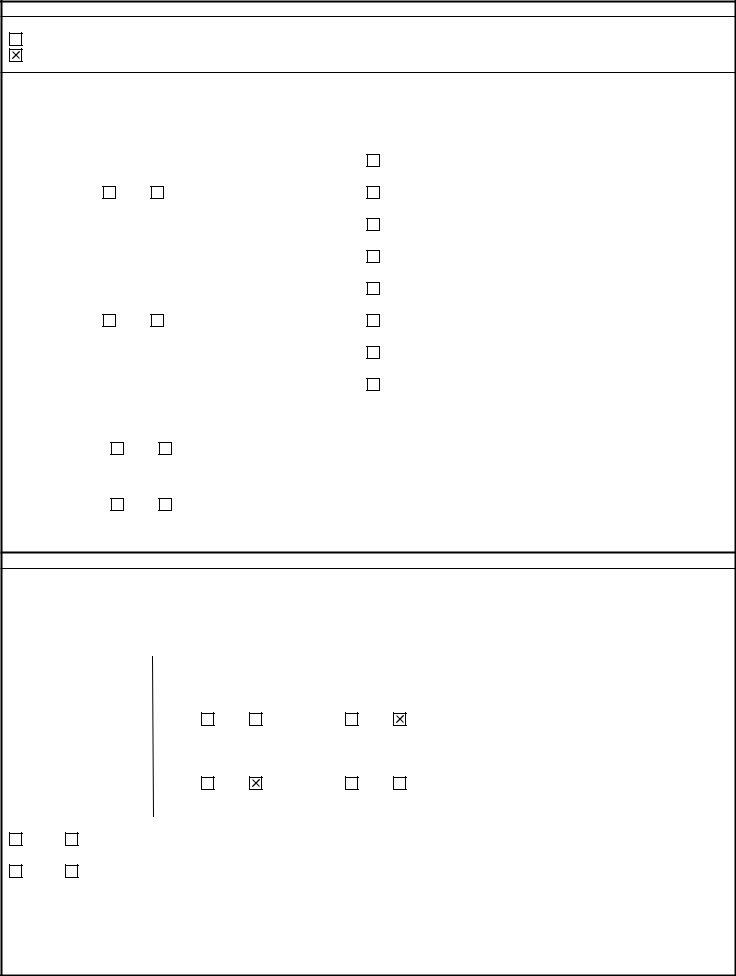
SECTION VI - FUNCTIONAL LOSS AND ADDITIONAL LIMITATION OF ROM (Continued)
6B. ARE ANY OF THE ABOVE FACTORS ASSOCIATED WITH LIMITATION OF MOTION?
YES (If yes, complete questions 6C and 6D)
NO (If no, proceed to question 6D)
6C. CONTRIBUTING FACTORS OF DISABILITY ASSOCIATED WITH LIMITATION OF MOTION
|
Can pain, weakness, fatigability, or |
If yes, please estimate ROM due to pain and/or |
If there is a functional loss due to pain, during flare-ups and/or |
Shoulder |
incoordination significantly limit functional |
when the joint is used repeatedly over a period of time but the |
ability during flare-ups or when the joint is |
functional loss during flare-ups or when the |
limitation of ROM cannot be estimated, please describe |
|
joint is used repeatedly over a period of time: |
|
used repeatedly over a period of time? |
the functional loss: |
|
|
|
|
|
|
|
|
|
|
|
|
|
|
|
|
|
|
|
|
|
|
|
|
|
|
Flexion |
|
|
|
|
Est. ROM is |
|
|
|
|
|
|
|
|
|
|
|
|
|
|
|
|
|
|
|
|
|
|
not feasible |
|
|
|
|
|
|
|
|
|
|
|
|
|
|
|
|
|
|
|
|
|
|
|
|
|
|
|
|
|
Yes |
|
No |
Abduction |
|
|
|
|
Est. ROM is |
|
|
|
|
|
|
|
|
|
|
|
|
|
|
|
|
|
|
not feasible |
|
RIGHT |
|
|
|
|
|
|
|
|
|
|
|
|
|
|
|
|
|
|
|
|
|
|
|
SHOULDER |
|
|
|
|
|
External |
|
|
|
|
Est. ROM is |
|
|
|
|
|
|
|
|
|
|
|
|
|
|
|
|
|
|
Rotation |
|
|
|
|
not feasible |
|
|
|
|
|
|
|
|
|
|
|
|
|
|
|
|
|
|
|
|
|
|
|
|
|
|
|
|
|
|
Internal |
|
|
|
|
Est. ROM is |
|
|
|
|
|
|
|
|
|
|
|
|
|
|
|
|
|
Rotation |
|
|
|
|
not feasible |
|
|
|
|
|
|
|
|
|
|
|
|
|
|
|
|
|
|
|
|
|
|
|
|
|
|
|
|
|
|
Flexion |
|
|
|
|
Est. ROM is |
|
|
|
|
|
|
|
|
|
|
|
|
|
|
|
|
|
|
|
|
|
|
not feasible |
|
|
|
|
|
|
|
|
|
|
|
|
|
|
|
|
|
|
|
|
|
|
|
|
|
|
|
|
|
Yes |
|
No |
Abduction |
|
|
|
|
Est. ROM is |
|
|
|
|
|
|
|
|
|
|
|
|
|
|
|
|
|
|
not feasible |
|
LEFT |
|
|
|
|
|
|
|
|
|
|
|
|
|
|
|
|
|
|
|
|
|
|
|
SHOULDER |
|
|
|
|
|
External |
|
|
|
|
Est. ROM is |
|
|
|
|
|
|
|
|
|
|
|
|
|
|
|
|
|
|
Rotation |
|
|
|
|
not feasible |
|
|
|
|
|
|
|
|
|
|
|
|
|
|
|
|
|
|
|
|
|
|
|
|
|
|
|
|
|
|
|
Internal |
|
|
|
|
Est. ROM is |
|
|
|
|
|
|
|
|
|
|
|
|
|
|
|
|
|
|
Rotation |
|
|
|
|
not feasible |
|
|
|
|
|
|
|
|
|
|
|
|
|
|
|
|
|
|
|
|
|
|
|
|
|
6D. CONTRIBUTING FACTORS OF DISABILITY NOT ASSOCIATED WITH LIMITATION OF MOTION
IS THERE ANY FUNCTIONAL LOSS (not associated with limitation of motion) DURING FLARE-UPS OR WHEN THE JOINT IS USED REPEATEDLY OVER A PERIOD OF TIME OR OTHERWISE?
RIGHT SHOULDER |
|
Yes |
|
No |
If yes, describe: |
LEFT SHOULDER |
|
Yes |
|
No |
If yes, describe: |
|
|
SECTION VII - MUSCLE STRENGTH TESTING
7A. MUSCLE STRENGTH - RATE STRENGTH ACCORDING TO THE FOLLOWING SCALE:
0/5 No muscle movement
1/5 Palpable or visible muscle contraction, but no joint movement 2/5 Active movement with gravity eliminated
3/5 Active movement against gravity
4/5 Active movement against some resistance 5/5 Normal strength
Shoulder |
Forward Flexion |
Rate |
Is there a reduction in |
If yes, is the reduction entirely due to the |
If no (the reduction is not entirely due to the |
/Abduction |
Strength |
|
muscle strength? |
claimed condition in the Diagnosis section? |
claimed condition), provide rationale: |
|
|
|
|
|
|
|
|
|
|
|
|
|
|
|
|
RIGHT |
Forward |
/5 |
|
|
|
|
|
|
|
|
|
|
|
SHOULDER |
Flexion |
|
|
|
|
|
|
|
|
|
|
|
|
|
|
|
|
|
|
|
|
|
|
|
|
|
|
|
|
Yes |
|
No |
|
|
Yes |
|
No |
|
|
Abduction |
/5 |
|
|
|
|
|
|
|
|
|
|
|
|
|
|
|
|
|
|
|
|
|
|
|
|
|
|
|
LEFT |
Forward |
/5 |
|
|
|
|
|
|
|
|
|
|
|
SHOULDER |
Flexion |
|
|
|
|
|
|
|
|
|
|
|
|
|
|
|
|
|
|
|
|
|
|
|
|
|
|
|
|
Yes |
|
No |
|
|
Yes |
|
No |
|
|
Abduction |
/5 |
|
|
|
|
|
|
|
|
|
|
|
|
|
|
|
|
|
|
|
|
|
|
|
|
|
|
|
|
|
|
|
|
|
7B. DOES THE VETERAN HAVE MUSCLE ATROPHY?
IF YES, IS THE MUSCLE ATROPHY DUE TO THE CLAIMED CONDITION IN THE DIAGNOSIS SECTION?
NO IF NO, PROVIDE RATIONALE:
VA FORM 21-0960M-12, MAY 2013 |
Page 5 |
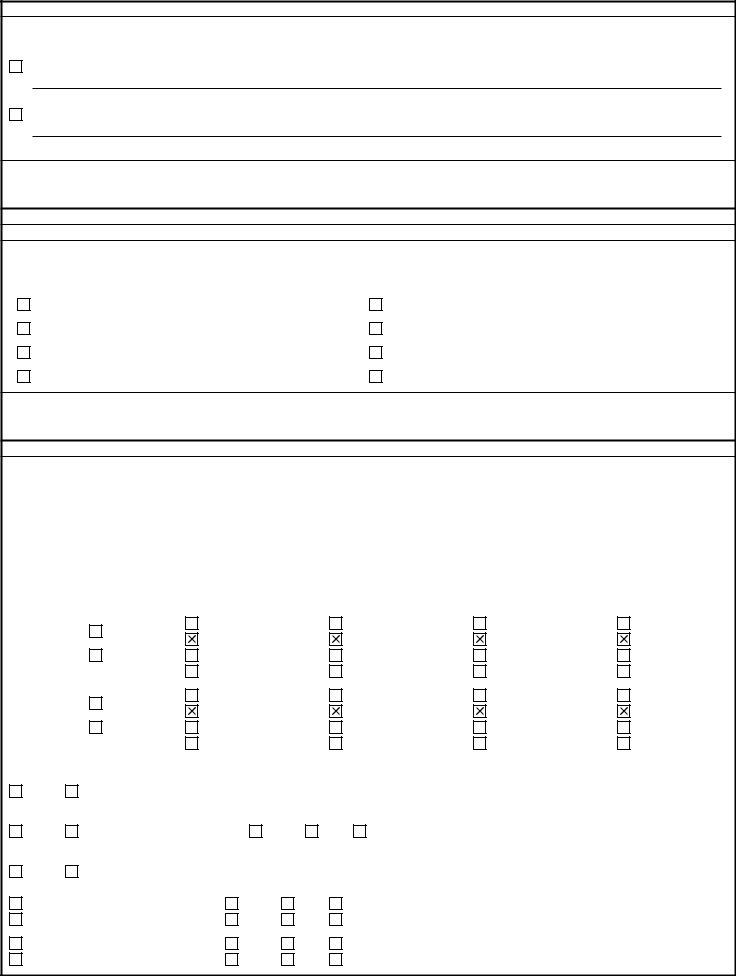
SECTION VII - MUSCLE STRENGTH TESTING (Continued)
FOR ANY MUSCLE ATROPHY DUE TO A DIAGNOSES LISTED IN SECTION 1, INDICATE SIDE AND SPECIFIC LOCATION OF ATROPHY, PROVIDING MEASUREMENTS IN CENTIMETERS OF NORMAL SIDE AND CORRESPONDING ATROPHIED SIDE, MEASURED AT MAXIMUM MUSCLE BULK.
LOCATION OF MUSCLE ATROPHY:
RIGHT UPPER EXTREMITY (specify location of measurement such as "10cm above or below elbow"):
CIRCUMFERENCE OF MORE NORMAL SIDE: |
|
cm CIRCUMFERENCE OF ATROPHIED SIDE: |
|
cm |
LEFT UPPER EXTREMITY (specify location of measurement such as "10cm above or below elbow"):
CIRCUMFERENCE OF MORE NORMAL SIDE: |
|
cm CIRCUMFERENCE OF ATROPHIED SIDE: |
|
cm |
7C. COMMENTS, IF ANY:
SECTION VIII - ANKYLOSIS
NOTE: Ankylosis is the immobilization and consolidation of a joint due to disease, injury or surgical procedure.
COMPLETE THIS SECTION IF THE VETERAN HAS ANKYLOSIS OF SCAPULOHUMERAL (glenohumeral) ARTICULATION (shoulder joint) (i.e., the scapula and humerus move as one piece).
8A. INDICATE SEVERITY OF ANKYLOSIS AND SIDE AFFECTED (check all that apply):
RIGHT SIDE: |
LEFT SIDE: |
|
|
Ankylosis in abduction up to 60 degrees; can reach mouth and head |
|
|
Ankylosis in abduction up to 60 degrees; can reach mouth and head |
|
|
|
|
|
|
(Favorable ankylosis) |
|
|
(Favorable ankylosis) |
|
|
|
|
Ankylosis in abduction between favorable and unfavorable
(Intermediate ankylosis)
Ankylosis in abduction at 25 degrees or less from side (Unfavorable
ankylosis)
Ankylosis in abduction between favorable and unfavorable
(Intermediate ankylosis)
Ankylosis in abduction at 25 degrees or less from side (Unfavorable
ankylosis)
8B. COMMENTS, IF ANY:
SECTION IX - ROTATOR CUFF CONDITIONS
9. ROTATOR CUFF CONDITIONS
SHOULDER |
IS ROTATOR CUFF |
|
|
|
|
|
|
|
|
|
|
|
|
|
|
IF "YES" COMPLETE THE FOLLOWING |
|
|
|
|
|
|
|
|
CONDITION |
HAWKINS' IMPINGEMENT TEST |
|
|
EMPTY-CAN TEST |
EXTERNAL ROTATION/ |
|
|
LIFT-OFF |
|
|
|
|
SUSPECTED? |
|
|
|
|
|
|
|
|
(Forward flex the arm to 90 |
(Abduct arm to 90 degrees and |
|
INFRASPINATUS |
SUBSCAPULARIS TEST |
|
|
|
|
|
|
|
|
|
|
|
|
|
|
|
|
|
|
STRENGTH TEST |
|
|
|
|
|
|
|
|
|
|
|
|
degrees with the elbow bent to 90 |
|
forward flex 30 degrees. |
|
(Patient internally rotates arm |
|
|
|
|
|
|
|
|
|
|
|
|
|
|
|
|
|
|
|
|
degrees. Internally rotate arm. |
Patient turns thumbs down and |
(Patient holds arms at side with |
behind lower back, pushes |
|
|
|
|
|
|
|
|
Pain on internal rotation |
resists downward force applied |
elbow flexed 90 degrees. Patient |
against examiner's hand. |
|
|
|
|
|
|
|
|
indicates a positive test; may |
|
by the examiner. Weakness |
externally rotates against |
Weakness indicates a positive |
|
|
|
|
|
|
|
|
signify rotator cuff tendinopathy |
indicates a positive test; may |
resistance. Weakness indicates a |
test; may indicate subscapularis |
|
|
|
|
|
|
|
|
|
|
or tear) |
|
|
|
|
indicate rotator cuff pathology, |
positive test; may be associated |
|
tendinopathy or tear) |
|
|
|
|
|
|
|
|
|
|
|
|
|
|
|
|
|
|
including supraspinatus |
with infraspinatus tendinopathy |
|
|
|
|
|
|
|
|
|
|
|
|
|
|
|
|
|
|
|
|
|
|
|
tendinopathy or tear) |
|
|
or tear) |
|
|
|
|
|
|
|
|
|
|
|
|
|
|
|
|
|
|
|
|
|
|
|
|
|
|
|
|
|
|
|
|
|
|
|
|
|
|
|
|
|
Yes |
|
|
Positive |
|
|
|
|
|
|
|
|
Positive |
|
|
Positive |
|
|
Positive |
|
|
|
|
|
|
|
|
|
|
|
|
|
|
|
|
|
|
|
|
|
|
|
|
|
|
|
|
|
|
|
|
|
|
|
|
|
|
|
|
|
|
|
RIGHT |
|
|
|
|
|
|
Negative |
|
|
|
|
|
|
|
|
Negative |
|
|
Negative |
|
|
Negative |
|
|
|
|
|
|
|
|
|
|
|
|
|
|
|
|
|
|
|
|
|
|
|
|
|
|
|
|
|
|
|
|
|
|
|
|
|
|
|
SHOULDER |
|
|
|
|
No |
|
|
Unable to perform |
|
|
|
|
Unable to perform |
|
|
Unable to perform |
|
|
Unable to perform |
|
|
|
|
|
|
|
|
|
|
|
|
|
|
|
|
|
|
|
|
|
|
|
|
|
|
|
|
|
|
|
|
|
|
|
|
|
|
|
|
|
N/A |
|
|
|
|
|
|
|
|
N/A |
|
|
N/A |
|
|
N/A |
|
|
|
|
|
|
|
|
|
|
|
|
|
|
|
|
|
|
|
|
|
|
|
|
|
|
|
|
|
|
|
|
|
|
|
|
|
|
|
|
|
|
|
|
|
|
|
|
|
|
|
|
|
|
|
|
|
|
|
Yes |
|
|
Positive |
|
|
|
|
|
|
|
|
Positive |
|
|
Positive |
|
|
Positive |
|
|
|
|
|
|
|
|
|
|
|
|
|
|
|
|
|
|
|
|
|
|
|
|
|
|
|
|
|
|
|
|
|
|
|
|
|
|
|
|
|
|
|
LEFT |
|
|
|
|
|
|
Negative |
|
|
|
|
|
|
|
|
Negative |
|
|
Negative |
|
|
Negative |
|
|
|
|
|
|
|
|
|
|
|
|
|
|
|
|
|
|
|
|
|
|
|
|
|
|
|
|
|
|
|
|
|
|
|
|
|
|
|
SHOULDER |
|
|
|
|
No |
|
|
Unable to perform |
|
|
|
|
Unable to perform |
|
|
Unable to perform |
|
|
Unable to perform |
|
|
|
|
|
|
|
|
|
|
|
|
|
|
|
|
|
|
|
|
|
|
|
|
|
|
|
|
|
|
|
|
|
|
|
|
|
|
|
|
|
N/A |
|
|
|
|
|
|
|
|
N/A |
|
|
N/A |
|
|
N/A |
|
|
|
|
|
|
|
|
|
|
|
|
|
|
|
|
|
|
|
|
|
|
|
|
|
|
|
|
|
|
|
|
|
|
|
|
|
|
|
|
|
|
|
|
|
|
|
|
|
|
|
|
|
|
|
|
|
|
|
|
SECTION X - SHOULDER INSTABILITY, DISLOCATION OR LABRAL PATHOLOGY |
|
|
|
|
|
|
|
|
|
|
|
|
|
|
|
|
|
|
|
|
|
|
|
|
|
|
10A. IS SHOULDER INSTABILITY, DISLOCATION OR LABRAL PATHOLOGY SUSPECTED? |
|
|
|
|
|
|
|
|
|
YES |
|
NO |
IF YES, COMPLETE QUESTIONS 10B - 10D BELOW: |
|
|
|
|
|
|
|
|
|
|
|
|
|
|
|
|
|
|
|
|
|
|
|
|
|
|
|
|
|
|
|
|
|
|
|
|
|
|
|
|
|
|
|
|
|
|
|
|
|
|
|
10B. IS THERE A HISTORY OF MECHANICAL SYMPTOMS (clicking, catching, etc.)? |
|
|
|
|
|
|
|
|
|
YES |
|
NO |
INDICATE SIDE AFFECTED: |
|
Right |
|
Left |
|
Both |
|
|
|
|
|
|
|
|
|
|
|
|
|
|
|
|
|
|
|
|
|
|
|
|
|
|
|
|
|
|
|
|
|
|
|
|
|
|
|
|
|
|
|
|
|
|
|
|
|
|
10C. IS THERE A HISTORY OF RECURRENT DISLOCATION (subluxation) OF THE GLENOHUMERAL (scapulohumeral) JOINT? |
|
|
|
|
|
|
YES |
|
NO |
|
|
|
|
|
|
|
|
|
|
|
|
|
|
|
|
|
|
|
|
|
|
|
|
|
|
|
|
|
|
|
|
|
|
|
|
|
|
|
|
|
|
|
|
|
|
|
|
|
IF YES, INDICATE FREQUENCY, SEVERITY AND SIDE AFFECTED (check all that apply): |
|
|
|
|
|
|
|
|
|
|
|
|
|
|
|
|
|
|
|
|
|
Both |
|
|
|
|
|
|
|
|
|
Infrequent episodes |
|
|
|
|
|
Right |
|
|
Left |
|
|
|
|
|
|
|
|
|
|
|
|
|
|
|
|
|
|
|
|
|
|
|
|
|
|
|
|
|
|
|
|
Frequent episodes |
|
|
|
|
|
|
Right |
|
|
Left |
|
|
Both |
|
|
|
|
|
|
|
Guarding of movement only at shoulder level Guarding of all arm movement
VA FORM 21-0960M-12, MAY 2013 |
Page 6 |
Left
Both
Right
Left
Left
Left
Left
Both
Both
Both
Both
Right
Right
Right
Right
SECTION X - SHOULDER INSTABILITY, DISLOCATION OR LABRAL PATHOLOGY (Continued)
10D. CRANK APPREHENSION AND RELOCATION TEST (with patient supine, abduct patient's arm to 90 degrees and flex elbow 90 degrees. Pain and sense of instability with further external rotation may indicate shoulder instability.)
POSITIVE NEGATIVE IF POSITIVE, SIDE AFFECTED:
|
UNABLE TO PERFORM |
|
N/A |
|
Right |
|
Left |
|
|
Both |
|
|
|
|
SECTION XI - CLAVICLE, SCAPULA, ACROMIOCLAVICULAR (AC) JOINT AND STERNOCLAVICULAR JOINT CONDITIONS
11A. IS A CLAVICLE, SCAPULA, ACROMIOCLAVICULAR (AC) JOINT OR STERNOCLAVICULAR JOINT CONDITION SUSPECTED?
|
|
YES |
|
NO |
IF YES, COMPLETE QUESTIONS 11B - 11D BELOW. |
|
|
|
|
|
|
11B. DOES THE VETERAN HAVE AN AC JOINT CONDITION OR ANY OTHER IMPAIRMENT OF THE CLAVICLE OR SCAPULA? |
|
|
YES |
|
NO |
|
|
|
|
|
IF YES, INDICATE SEVERITY AND SIDE AFFECTED:
Malunion of clavicle or scapula
Nonunion of clavicle or scapula without loose movement
Nonunion of clavicle or scapula with loose movement
Dislocation (acromioclavicular separation or sternoclavicular dislocation)
Other (Describe)
11C. IS THERE TENDERNESS ON PALPATION OF THE AC JOINT? |
|
YES |
NO IF YES, INDICATE SIDE: |
Right |
Left |
11D. CROSS-BODY ADDUCTION TEST (Passively adduct arm across the patient's body toward the contralateral shoulder. Pain may indicate acromioclavicular joint
pathology)
POSITIVE NEGATIVE IF POSITIVE, SIDE AFFECTED:
|
UNABLE TO PERFORM |
|
N/A |
|
Right |
|
Left |
|
|
Both |
|
|
|
|
SECTION XII - CONDITIONS OR IMPAIRMENTS OF THE HUMERUS
12A. DOES THE VETERAN HAVE LOSS OF HEAD (flail shoulder), NONUNION (false flail shoulder), OR FIBROUS UNION OF THE HUMERUS?
|
|
YES |
|
NO |
|
|
|
|
|
|
IF YES, CHECK ALL THAT APPLY: |
|
|
|
|
|
|
|
|
Loss of head (flail shoulder) |
|
Right |
|
Left |
|
Both |
|
|
|
|
|
|
|
Nonunion (false flail shoulder) |
|
Right |
|
Left |
|
Both |
|
|
|
|
|
|
|
Fibrous union |
|
Right |
|
Left |
|
Both |
|
|
|
|
|
|
12B. DOES THE VETERAN HAVE MALUNION OF THE HUMERUS WITH MODERATE OR MARKED DEFORMITY? |
|
|
YES |
|
NO |
|
|
|
|
|
|
|
|
|
|
|
|
|
|
|
IF YES, CHECK ALL THAT APPLY: |
|
|
|
|
|
|
|
|
Moderate deformity |
|
Right |
|
Left |
|
Both |
|
|
|
|
|
|
|
Marked deformity |
|
Right |
|
Left |
|
Both |
|
|
|
|
|
12C. COMMENTS, IF ANY:
SECTION XIII - SURGICAL PROCEDURES
13. INDICATE ANY SURGICAL PROCEDURES THAT THE VETERAN HAS HAD PERFORMED AND PROVIDE THE ADDITIONAL INFORMATION AS REQUESTED
(check all that apply):
RIGHT SIDE:
TOTAL SHOULDER JOINT REPLACEMENT
DATE OF SURGERY:
RESIDUALS:
None
Intermediate degrees of residual weakness, pain or limitation of motion
Chronic residuals consisting of severe painful motion or weakness
Other, describe:
ARTHROSCOPIC OR OTHER SHOULDER SURGERY
TYPE OF SURGERY:
DATE OF SURGERY:
RESIDUALS OF ARTHROSCOPIC OR OTHER SHOULDER SURGERY DESCRIBE RESIDUALS:
LEFT SIDE:
TOTAL SHOULDER JOINT REPLACEMENT
DATE OF SURGERY:
RESIDUALS:
None
Intermediate degrees of residual weakness, pain or limitation of motion
Chronic residuals consisting of severe painful motion or weakness
Other, describe:
ARTHROSCOPIC OR OTHER SHOULDER SURGERY
TYPE OF SURGERY:
DATE OF SURGERY:
RESIDUALS OF ARTHROSCOPIC OR OTHER SHOULDER SURGERY DESCRIBE RESIDUALS:
VA FORM 21-0960M-12, MAY 2013 |
Page 7 |
SECTION XIV - OTHER PERTINENT PHYSICAL FINDINGS, COMPLICATIONS, CONDITIONS, SIGNS, SYMPTOMS AND SCARS
14A. DOES THE VETERAN HAVE ANY OTHER PERTINENT PHYSICAL FINDINGS, COMPLICATIONS, CONDITIONS, SIGNS OR SYMPTOMS, OR ANY SCARS (surgical or otherwise) RELATED TO ANY CONDITIONS OR TO THE TREATMENT OF ANY CONDITIONS LISTED IN THE DIAGNOSIS SECTION ABOVE?
|
NO |
IF YES, COMPLETE QUESTIONS 14B-14D. |
14B. DOES THE VETERAN HAVE ANY OTHER PERTINENT PHYSICAL FINDINGS, COMPLICATIONS, CONDITIONS, SIGNS OR SYMPTOMS RELATED TO ANY CONDITIONS LISTED IN THE DIAGNOSIS SECTION ABOVE?
|
NO |
IF YES, DESCRIBE (brief summary): |
14C. DOES THE VETERAN HAVE ANY SCARS (surgical or otherwise) RELATED TO ANY CONDITIONS OR TO THE TREATMENT OF ANY CONDITIONS LISTED IN THE DIAGNOSIS SECTION ABOVE?
IF YES, ARE ANY OF THESE SCARS PAINFUL OR UNSTABLE; HAVE A TOTAL AREA EQUAL TO OR GREATER THAN 39 SQUARE CM (6 square inches); OR ARE LOCATED ON THE HEAD, FACE OR NECK?
|
NO |
IF YES, ALSO COMPLETE VA FORM 21-0960F-1, SCARS/DISFIGUREMENT. |
IF NO, PROVIDE LOCATION AND MEASUREMENTS OF SCAR IN CENTIMETERS.
Location: |
|
Measurements: length |
|
cm X width |
|
cm. |
NOTE: An "unstable scar" is one where, for any reason, there is frequent loss of covering of the skin over the scar. If there are multiple scars, enter additional locations and measurements in Comment section below. It is not necessary to also complete a Scars DBQ.
14D. COMMENTS, IF ANY:
SECTION XV - ASSISTIVE DEVICES
15A. DOES THE VETERAN USE ANY ASSISTIVE DEVICES?
|
|
NO |
IF YES, IDENTIFY ASSISTIVE DEVICES USED (check all that apply and indicate frequency): |
|
|
|
|
Frequency of use: |
|
Occasional |
|
Regular |
|
Constant |
|
|
|
|
|
|
|
|
|
|
|
Frequency of use: |
|
Occasional |
|
Regular |
|
Constant |
|
|
|
|
|
|
|
|
|
|
|
|
|
|
|
|
|
|
15B. IF THE VETERAN USES ANY ASSISTIVE DEVICES, SPECIFY THE CONDITION AND IDENTIFY THE ASSISTIVE DEVICE USED FOR EACH CONDITION:
SECTION XVI - REMAINING EFFECTIVE FUNCTION OF THE EXTREMITIES
16A. DUE TO THE VETERAN'S SHOULDER OR ARM CONDITIONS, IS THERE FUNCTIONAL IMPAIRMENT OF AN EXTREMITY SUCH THAT NO EFFECTIVE FUNCTIONS REMAIN OTHER THAN THAT WHICH WOULD BE EQUALLY WELL SERVED BY AN AMPUTATION WITH PROSTHESIS? (Functions of the upper
extremity include grasping, manipulation, etc., while functions for the lower extremity include balance and propulsion, etc.)
YES, FUNCTIONING IS SO DIMINISHED THAT AMPUTATION WITH PROTHESIS WOULD EQUALLY SERVE THE VETERAN.
NO
IF YES, INDICATE EXTREMITIES FOR WHICH THIS APPLIES:
FOR EACH CHECKED EXTREMITY, IDENTIFY THE CONDITION CAUSING LOSS OF FUNCTION, DESCRIBE LOSS OF EFFECTIVE FUNCTION AND PROVIDE SPECIFIC EXAMPLES (brief summary):
NOTE: The intention of this section is to permit the examiner to quantify the level of remaining function; it is not intended to inquire whether the Veteran should undergo an amputation with fitting of a prothesis. For example, if the functions of grasping (hand) or propulsion (foot) are as limited as if the Veteran had an amputation and prosthesis, the examiner should check "yes" and describe the diminished functioning. The question simply asks whether the functional loss is to the same degree as if there were an amputation of the affected limb.
SECTION XVII - DIAGNOSTIC TESTING
NOTE: Testing listed below is not indicated for every condition. The diagnosis of degenerative arthritis (osteoarthritis) or traumatic arthritis must be confirmed by imaging studies. Once such arthritis has been documented, even if in the past, no further imaging studies are required by VA, even if arthritis has worsened.
17A. HAVE IMAGING STUDIES OF THE SHOULDER BEEN PERFORMED AND ARE THE RESULTS AVAILABLE?
YES NO
IF YES, IS DEGENERATIVE OR TRAUMATIC ARTHRITIS DOCUMENTED?
|
YES |
|
NO |
IF YES, INDICATE SHOULDER: |
|
RIGHT |
|
VA FORM 21-0960M-12, MAY 2013 |
Page 8 |
|
|
|
|
|
SECTION XVII - DIAGNOSTIC TESTING (Continued) |
17B. ARE THERE ANY OTHER SIGNIFICANT DIAGNOSTIC TEST FINDINGS OR RESULTS? |
|
|
YES |
|
NO |
IF YES, PROVIDE TYPE OF TEST OR PROCEDURE, DATE AND RESULTS (brief summary): |
|
|
|
17C. IS THERE OBJECTIVE EVIDENCE OF CREPITUS?
|
YES |
|
NO |
IF YES, INDICATE SHOULDER: |
|
17D. IF ANY TEST RESULTS ARE OTHER THAN NORMAL, INDICATE RELATIONSHIP OF ABNORMAL FINDINGS TO DIAGNOSED CONDITIONS:
SECTION XVIII - FUNCTIONAL IMPACT
NOTE: Provide the impact of only the diagnosed condition(s), without consideration of the impact of other medical conditions or factors, such as age.
18.REGARDLESS OF THE VETERAN'S CURRENT EMPLOYMENT STATUS, DO THE CONDITION(S) LISTED IN THE DIAGNOSIS SECTION IMPACT HIS OR HER ABILITY TO PERFORM ANY TYPE OF OCCUPATIONAL TASK (such as standing, walking, lifting, sitting, etc.)?
|
NO |
IF YES, DESCRIBE THE FUNCTIONAL IMPACT OF EACH CONDITION, PROVIDING ONE OR MORE EXAMPLES: |
SECTION XIX - REMARKS
19. REMARKS, IF ANY:
SECTION XX - PHYSICIAN'S CERTIFICATION AND SIGNATURE
CERTIFICATION - To the best of my knowledge, the information contained herein is accurate, complete and current.
20A. PHYSICIAN'S SIGNATURE
20B. PHYSICIAN'S PRINTED NAME
20D. PHYSICIAN'S PHONE NUMBER
20E. PHYSICIAN'S MEDICAL LICENSE NUMBER
NOTE: VA may request additional medical information, including additional examinations, if necessary to complete VA's review of the veteran's application.
IMPORTANT - Physician please fax the completed form to
(VA Regional Office FAX No.)
NOTE: A list of VA Regional Office FAX Numbers can be found at www.vba.va.gov/disabilityexams or obtained by calling 1-800-827-1000.
PRIVACY ACT NOTICE: VA will not disclose information collected on this form to any source other than what has been authorized under the Privacy Act of 1974 or Title 38, Code of Federal Regulations 1.576 for routine uses (i.e., civil or criminal law enforcement, congressional communications, epidemiological or research studies, the collection of money owed to the United States, litigation in which the United States is a party or has an interest, the administration of VA programs and delivery of VA benefits, verification of identity and status, and personnel administration) as identified in the VA system of records, 58/VA21/22/28, Compensation, Pension, Education and Vocational Rehabilitation and Employment Records - VA, published in the Federal Register. Your obligation to respond is required to obtain or retain benefits. VA uses your SSN to identify your claim file. Providing your SSN will help ensure that your records are properly associated with your claim file. Giving us your SSN account information is voluntary. Refusal to provide your SSN by itself will not result in the denial of benefits. VA will not deny an individual benefits for refusing to provide his or her SSN unless the disclosure of the SSN is required by a Federal Statute of law in effect prior to January 1, 1975, and still in effect. The requested information is considered relevant and necessary to determine maximum benefits under the law. The responses you submit are considered confidential (38 U.S.C. 5701). Information submitted is subject to verification through computer matching programs with other agencies.
RESPONDENT BURDEN: We need this information to determine entitlement to benefits (38 U.S.C. 501). Title 38, United States Code, allows us to ask for this information. We estimate that you will need an average of 30 minutes to review the instructions, find the information, and complete the form. VA cannot conduct or sponsor a collection of information unless a valid OMB control number is displayed. You are not required to respond to a collection of information if this number is not displayed. Valid OMB control numbers can be located on the OMB Internet Page at www.reginfo.gov/public/do/PRAMain. If desired, you can call 1-800-827-1000 to get information on where to send comments or suggestions about this form.
VA FORM 21-0960M-12, MAY 2013 |
Page 9 |

